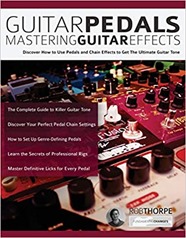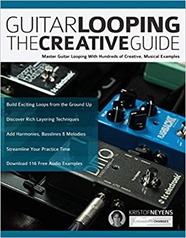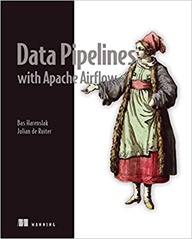 Another brief sojourn with a guitar related book, this time Guitar Pedals by Rob Thorpe. It has the lengthy subtitle "Discover How to Use Pedals and Chain Effects to Get The Ultimate Guitar Tone", and the front cover continues with a range of other promises as to content. This isn’t intended as a criticism, it just struck me as an usual stylistic effect.
Another brief sojourn with a guitar related book, this time Guitar Pedals by Rob Thorpe. It has the lengthy subtitle "Discover How to Use Pedals and Chain Effects to Get The Ultimate Guitar Tone", and the front cover continues with a range of other promises as to content. This isn’t intended as a criticism, it just struck me as an usual stylistic effect.
For those not familiar with electric guitars, an guitar effect pedal is a little box of electronics, around the size of a cigarette packet but rather thicker, with a socket on one side to take input from a lead from your guitar and a socket on the other side to send the modified signal out to your amplifier. On the top face of the pedal is a switch to turn the effect on and off, and one or more knobs to configure it. Guitar pedals are usually grouped together on a pedalboard which will hold up to 10 or so of them, chaining their effects together. They introduce effects such as distortion, reverb, delay and so forth.
If you watch videos of live music you’ll most likely notice the guitarist and bass player with a pedalboard on the floor at their feet, occasionally poking it with a foot to change the sound of their guitar.
Guitar pedals are a cheap and easy way of changing the way your guitar, I have a couple of more expensive Boss pedals which cost about £100 and a couple of Donner pedals which were under £40.
Guitar Pedals runs through chapters describing a bunch of distinct effects, talking first about the background of the effect before going through some short examples of the effect in different contexts with different configurations (these appear as written guitar tabs, and accompanying downloadable audio files), and finishing with some examples in real music.
Since reading "The Birth of Loud" by Ian S. Port it struck me that much of the development of the electric guitar and its ecosystem has been the story of electrical equipment abused. Particularly so with distortion /overdrive pedals described in the first chapter – the original distortion pedal made by Gibson in 1962 (the Maestro FZ-1) attempted to replicate the effect Link Wray achieved in Rumble by stabbing his speakers with a screwdriver! Jimi Hendrix was a fan of the Arbiter Fuzz Face but quality control was so poor he would buy a bunch of them and pick the best (or even get his guitar tech to cobble together a pedal from the parts of multiple examples). Purple Haze is an example of Fuzz Face in action. Overdrive is what you get when you turn the volume of your amplifier right up – pedals can achieve the same effect without making a really loud noise.
Next up is a chapter on delay – essentially an echo effect which was originally implemented on tape. I’ve always thought of delay effects and reverb being related with reverb the more important of the two. Reverb and compressor effects each get their own chapter but Thorpe sees them as more production effects than pedal effects per se. Tracks like Beautiful Day by U2, King of Zion Dub by King Tubby and Country Boy by Albert Lee use delay.
The chapter on modulation effects covers phasor and flanger effects, where part of the signal is phase shifted and mixed with the original signal. Shine on you crazy diamonds by Pink Floyd is an example of a phaser in use, and Barracuda by Heart uses a flanger. Also included are chorus effects (where part of the signal is delayed) and tremolo (where the volume is modulated). The first chorus pedal, the Roland CE-1 started life in Roland’s Jazz-Chorus 120 Amplifier. A background in physics is quite handy here, vibrations and waves are at the heart of any physics degree, as are operational amplifiers – pedal effects are these things in action! Come as you are by Nirvana is a good example of the chorus effect, and How soon is now by The Smiths demonstrates the tremolo effect (for this performance the tremolo effect comes from the amplifier rather than a pedal).
My wah pedal is my favourite, and it gets a chapter largely of its own. Think Voodoo Child by Jimi Hendrix (watch his left foot at the start of this video) or the theme from Shaft by Isaac Hayes. A wah pedal is an adjustable band pass filter, in the same why that the tone knob on any manner of audio equipment is an adjustable low-pass filter. The wah pedal is unusual in that you adjust it during play – the position of the pedal controls where the band pass sits, other pedals have their configuration set before hand and are simply switched on and off. All I can say is it’s great fun to play with!
Next up are octave pedals and other pitch shifters and harmonisers, I’d assumed the point of an octave pedal (which plays a note one octave above or below the note you are playing) was to emulate a bass guitar, but it seems not.Jimi Hendrix’s Octavia pedal added a tone an octave above what he was playing, on tracks like Fire and Purple Haze. Jack White of The White Stripes uses octave effects to add notes both an octave above and below the played note to give a "thicker" tone – try tracks like Ball and a biscuit and Blue orchid.
Originally effect pedals contained simple analog electronic circuits (or even liquids) which did one job, now with digital processing a single pedal can emulate many different effects. I must admit I find multi-effects pedals a bit overwhelming – it’s no fun trying to navigate 50 or so effects, and their configuration on a one inch display with a couple of buttons.
The book finishes with a chapter on ordering of guitar pedals, and how this can change the sound made and finally there are some interviews with professional guitarists, and how they arrange their pedals. A point that both Thorpe and one of his interviewees makes is that tone, the sound of the guitar, depends a lot on the player and how they play. Chasing after a tone by buying the same pedals as your heroes is a losing game.
Guitar Pedals is a short book, it doesn’t have the high production values of the Rikky Rooksby but it carries much of the style – embedding the example riffs in the chapters works really well for this book. Online guitar courses tend not to cover effects pedals, this book fills the gap pretty well.
 For completeness I include my review of Guitar Looping: The Creative Guide by Kristof Neyens. This is in the same series as Guitar Pedals by Rob Thorpe. These are both quite short books but I’ve found them useful.
For completeness I include my review of Guitar Looping: The Creative Guide by Kristof Neyens. This is in the same series as Guitar Pedals by Rob Thorpe. These are both quite short books but I’ve found them useful.

